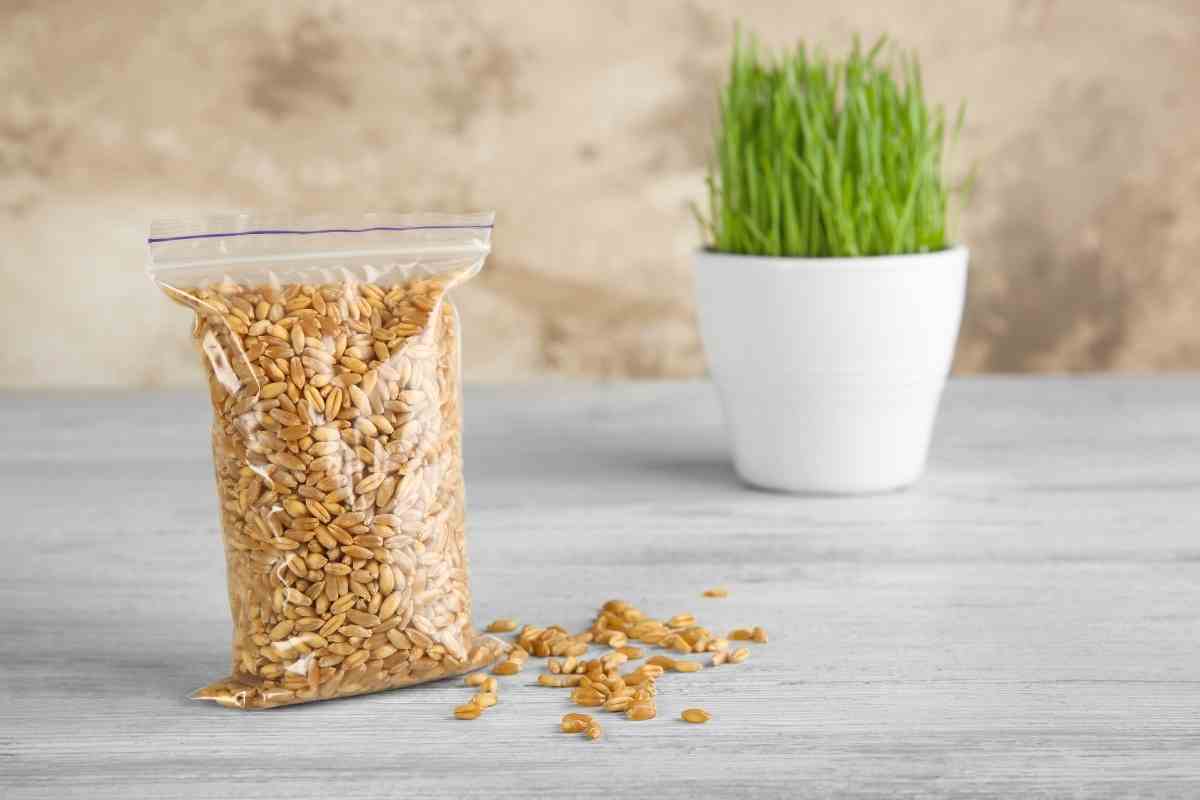Wheatgrass is one of the easiest plants to grow at home, even if you don’t have a green thumb.
All you need is seeds and a proper sprouting kit, and your crop will be ready for harvesting within a week after planting.
But what wheatgrass seeds for sprouting are the best?
3 Best Wheatgrass Seeds For Sprouting
Here are the standout wheatgrass seeds available in the market.
1. Back to the Roots Organic Wheatgrass Seeds
Back to the Roots Organic Wheatgrass Seeds are chemical-free, making them suitable for human and pet consumption.
Cats love this product because it produces a crop rich in fiber and protein, and protects against hairballs. In humans, it improves digestion and nutrient absorption.
Growing these seeds is simple – if you water them once daily, your crop will be ready for harvesting within a week after planting.
The yield is usually enough to sustain you and your pets for at least a month.
Regarding nutrition, these seeds have it in abundance.
Pros
- Easy to use and grow
- Value for money
- Safe for humans and pets
Cons
- Doesn’t come with an instruction guide
One serving of wheatgrass juice from the seeds contains vitamins B6 and E, manganese, and zinc, which are valuable additions to your workout shakes or your pet’s food.
2. Handy Pantry Certified Organic Hard Red Wheat Sprouting Seed
When purchasing wheatgrass seeds, you choose between chemical-free and certified organic.
Both grow without chemicals, but the latter contains natural organisms that aid in nutrient absorption when grown on organic soil.
Handy Pantry produces certified organic wheatgrass seeds that contain several nutrients that improve your overall well-being.
For instance, wheatgrass juice is rich in chlorophyll, a natural detoxifier. It also contains fiber that prevents constipation and multiple vitamins to boost your immunity.
Pros
- High germination rate
- Organic, GMO-free seeds
- 100% money-back guarantee
- Suitable for large families
Cons
- Produces bad odor if soaked for many days
Moreover, each bag of this product contains enough seeds to fill a standard 10″ x20″ container.
3. COUNTRY CREEK ACRES Hard Red Non-GMO Wheatgrass
A perfect all-rounder, this product can grow in sprouting kits and your garden. It’s rich in healthy nutrients and suitable for you and your pets, such as cats, dogs, and rabbits.
This product’s versatility makes it a great gift to pet lovers. It’s also a natural remedy to hairballs, a problem caused by overconsumption of fiber-deficient meals.
In humans, it helps in fighting constipation and indigestion.
Pros
- Fast growth rate
- High nutritional value
- Suitable for humans and pets
Cons
- Some cats do not like it
Furthermore, the packaging bag is re-sealable. You can repurpose it for other uses once you sprout your seeds.
How to Grow Wheatgrass
Below is a systematic guide on how to sprout wheatgrass.
Requirements
Here’s what you’ll need before growing wheatgrass.
- Wheatgrass sprouting seeds
- Organic potting mix
- Shallow sprouting tray
- Glass container
- Strainer
- Newspaper
- Spray bottle with water
- A pair of scissors
Procedure
After gathering the required items, do the following:
Soak the Seeds Overnight
Place the sprouting seeds in the glass container, then add water until halfway full.
You might need to add more water if the seeds are many.
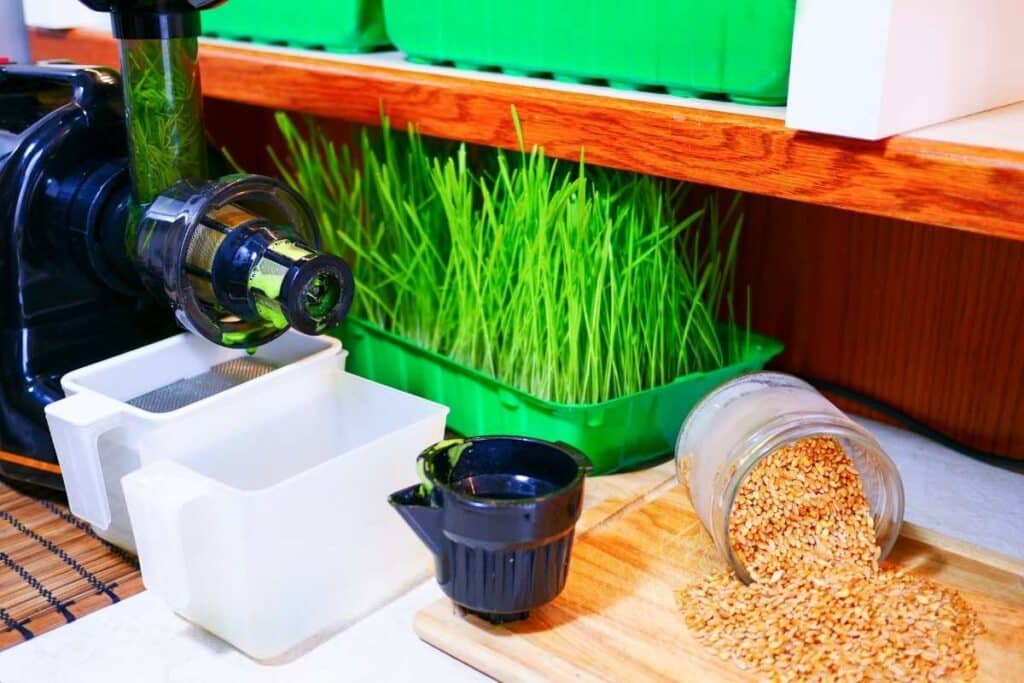
The objective is to ensure that the water’s meniscus exceeds the seeds’ by at least an inch.
Then – Allow the seeds to soak overnight. Soaking softens the seed coat and initiates water absorption.
Prep the Growing Container
Add an inch of the potting mix to your growing container.
Ensure that the mix spreads evenly throughout the tray.
Strain and Plant Your Seeds
The morning after soaking the seeds, strain the water and sprinkle them over the potting mix.
Then, cover them with a thin layer of dirt.
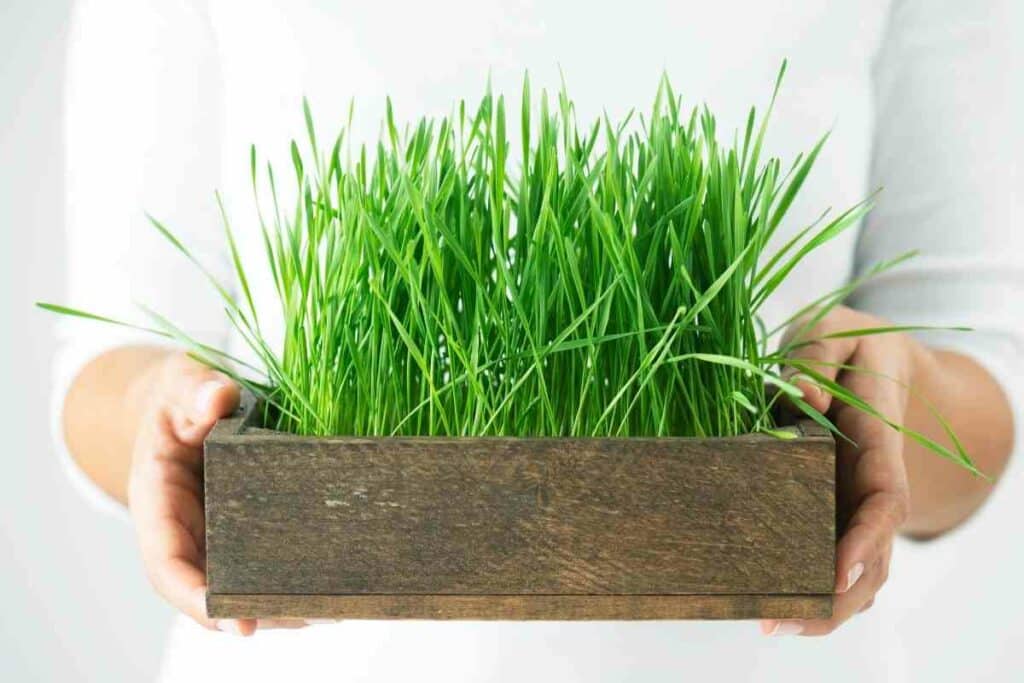
Water the Seeds
Water the seeds using the spray bottle.
Please do this moderately, as drenching increases the risk of mold and fungal infections.
Cover with Newspaper
Cover the growing container with a single sheet of newspaper, then water it until it’s wet.
The newspaper creates a dark and moist environment, the ideal conditions for sprouting wheatgrass seeds.
Water the newspaper frequently until the sprouts appear.
Move the Sprouter to a Sunny Spot
Sprouts usually appear on the third day after planting.
Once this happens, remove the newspaper and move the growing container to a sunny spot.
You’ll need to water the plant more often to prevent dehydration.
If you’re growing the wheatgrass indoors, artificial lighting can provide similar benefits to the sun.
Harvest Your Crop
Seven days after planting, your wheatgrass should be ready for harvesting.
Using your scissors, cut the grass.
Don’t cut the entire blades if you want plants to continue growing. Instead, cut not more than ⅔ of the grass. Otherwise, cut the entire blade.
Keep In Mind – It isn’t advisable to regrow existing wheatgrass plants. As a plant ages, it loses its nutritional value.
Factors to Consider before Sprouting Wheatgrass
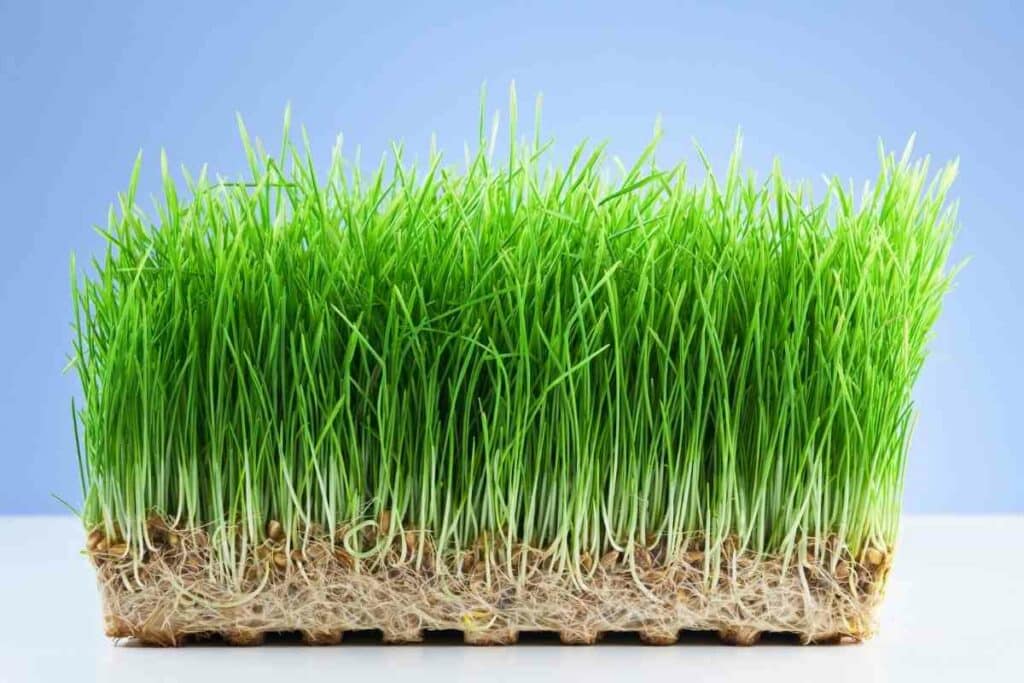
Before you start sprouting wheatgrass, consider the following.
Wheatgrass Growing Trays
You can grow wheatgrass in different containers, specialized microgreen trays, plastic starter kits, or repurposed takeout containers.
It’s wise to avoid regular plastic, regardless of your container. If you must, go for food-grade BPA-free plastic.
Clay or glass are the best because they are non-toxic to humans. However, they’re more fragile than plastic.
Wheatgrass Seeds
Please avoid using regular seeds for sprouting.
Take your time to find certified and reputable wheatgrass sprouting seeds.
Most sprouting seeds have unique names, such as ‘wheatgrass berries’ or ‘hard winter wheat seeds.’
Potting Mix
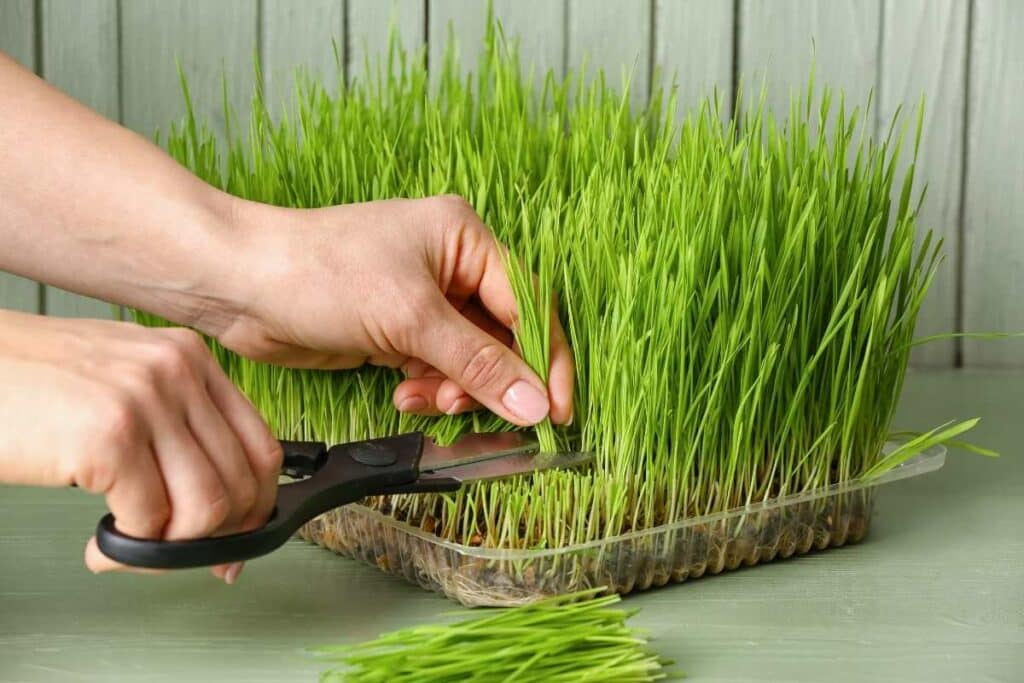
Here, you can choose a soil-based or a soil-less growing medium.
Regardless, ensure that your choice is organic.
Choosing a mix with strong fertilizer can hurt your seeds or make the sprouts toxic to consumers.
Strainer
Although it seems unimportant, a strainer makes planting easier.
Whether its metal or plastic, ensure that your strainer has holes smaller than the seeds to avoid loss.
Some dedicated wheatgrass trays come with an inbuilt strainer
How to Use Wheatgrass
Most people use wheatgrass juice to add nutritional value to other drinks, such as beverages and smoothies.
For instance, you can add wheatgrass juice to your protein shake to give you more energy during your workout. Others use the plant as a topping for their salads.
It’s worth noting that wheatgrass juice can cause stomach upsets in first-time users.
Other side effects include:
- fatigue
- headaches
- and nausea
If this happens to you, reduce your intake to 30ml per drink in the first few days. Then, continue to add as your body adjusts to the plant.
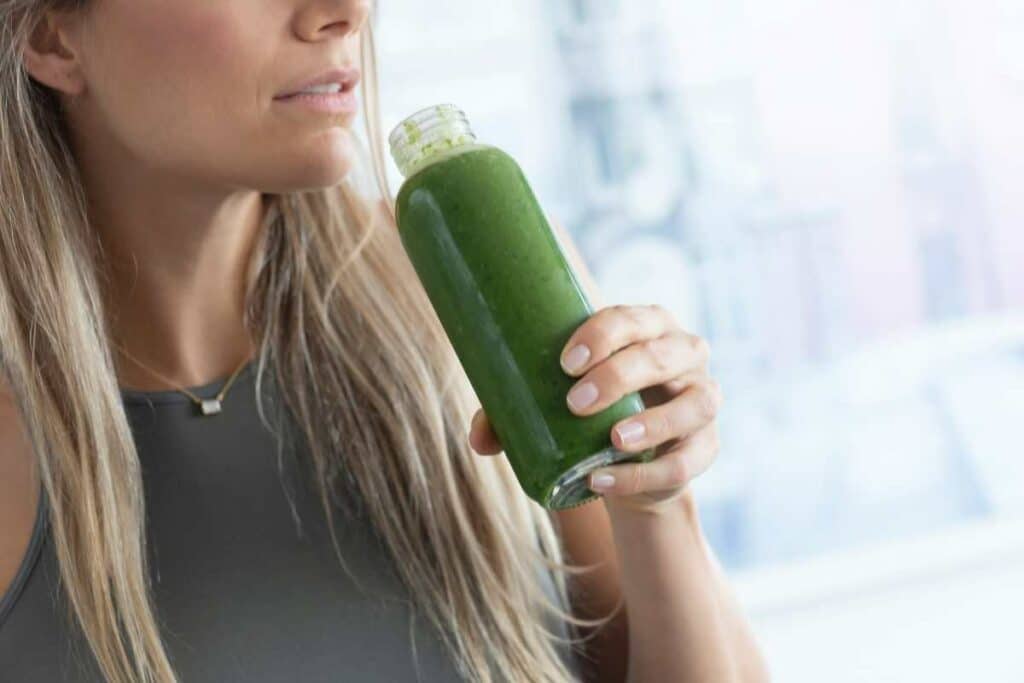
Interestingly, wheatgrass juice has other uses besides ingestion.
For example, bathing in water induced with the juices cleanses your skin and reduces acne and scarring.
Some people use the juice to fight dandruff and soften skin.
The Benefits of Wheatgrass
Wheatgrass is a nutritious plant. It contains several vitamins A, C, and E and eight essential amino acids.
These are proteins that your body can’t synthesize, meaning you have to ingest them.
The plant is also rich in various minerals, including calcium, iron, and magnesium.
Additionally, wheatgrass has many antioxidants.
These prevent cell damage resulting from excessive oxidation. Over time, antioxidants reduce the risk of various cancers, heart disease, and other serious illnesses.
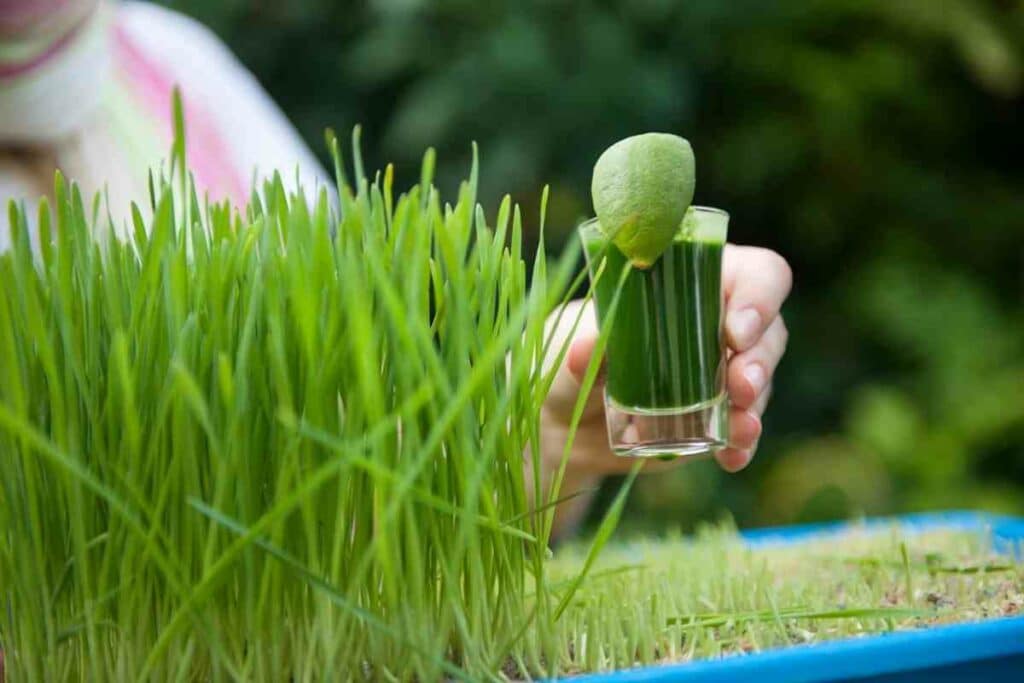
Wheatgrass is among the best sources of living chlorophyll, especially its juice. Chlorophyll is precious to human beings as it is to plants.
In humans, it aids in blood formation and detoxification, reducing tissue inflammation, and lowering the risk of various cancers.
Lastly: Wheatgrass helps in weight regulation. It contains thylakoids that suppress appetite and increase the feeling of satiety by inhibiting the release of ghrelin, a hormone that makes you feel hungry.
Taking Care of Wheatgrass
The most crucial element of wheatgrass care is providing optimal growth conditions.
Ensure that the growing media is moist but not saturated.
Provide adequate lighting when the sprouts emerge. Use the right equipment for harvesting your crop.
It’s also advisable to use the growing media once every planting cycle. Reusing exhausts the nutrients, resulting in poor yields.
Final Words
Growing food doesn’t always mean you have to wait for months to harvest your crop – nor must you have a huge farm.
Microgreens, such as wheatgrass, are easy to grow, mature fast, and require little maintenance.
Moreover, wheatgrass is rich in nutrients. It improves physical well-being and lowers the risk of many diseases. Like other green plants, it adds beauty to your home.
What’s your excuse? Plant wheatgrass now and enjoy its numerous benefits!
